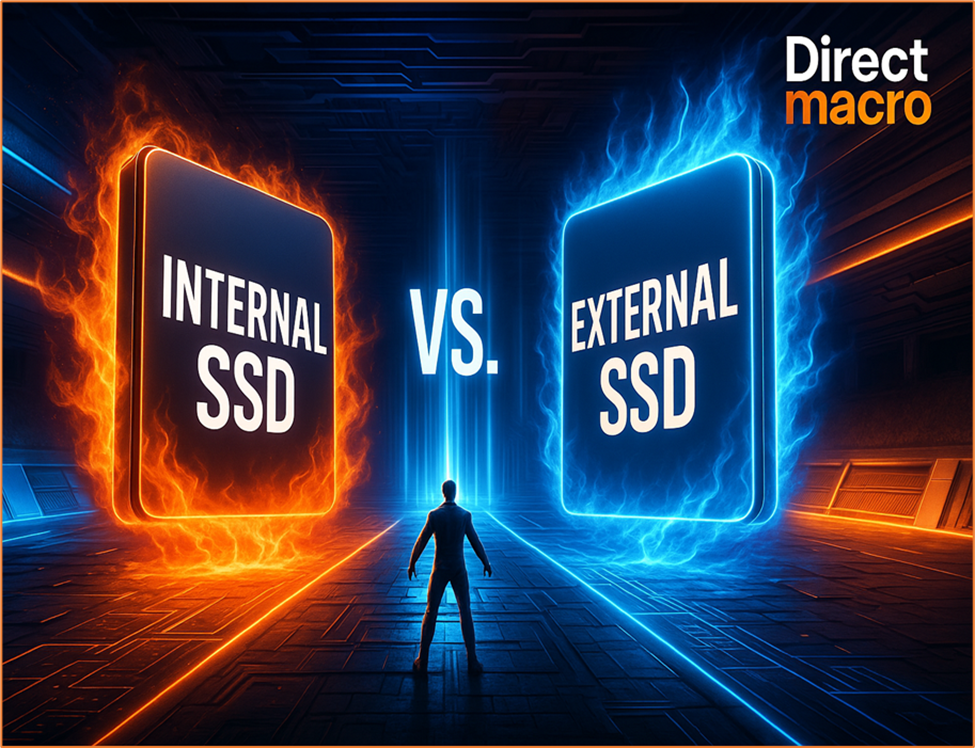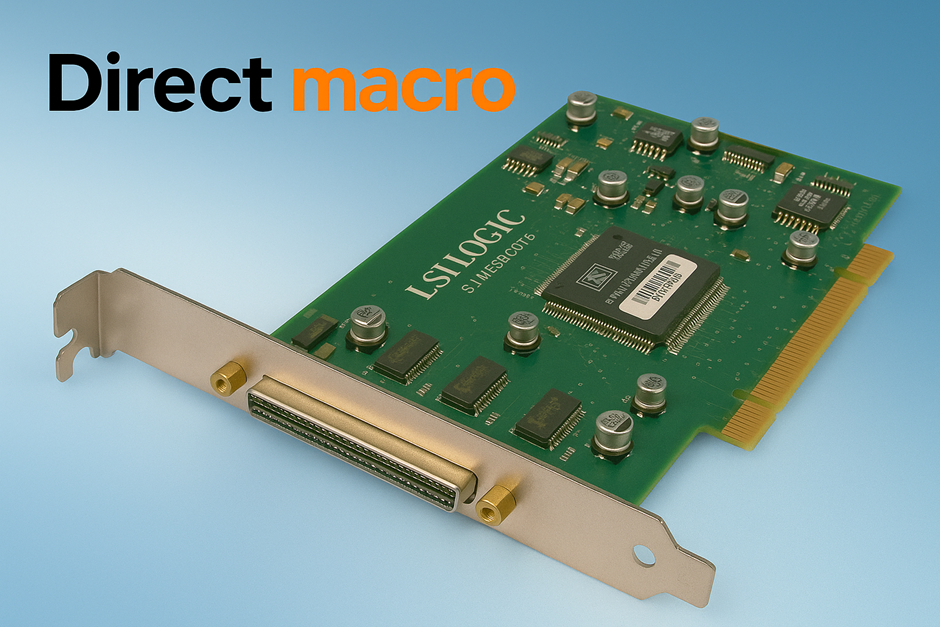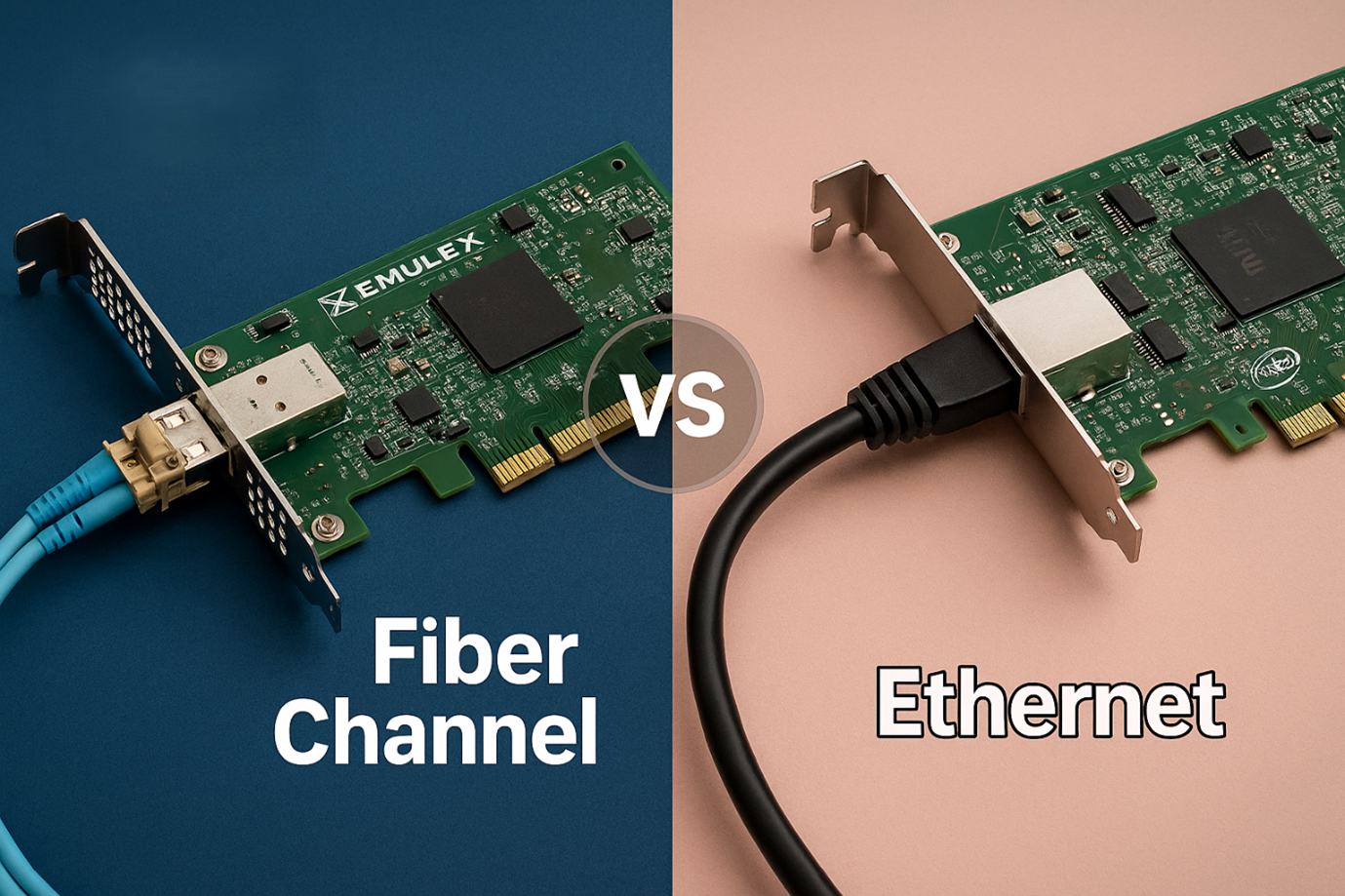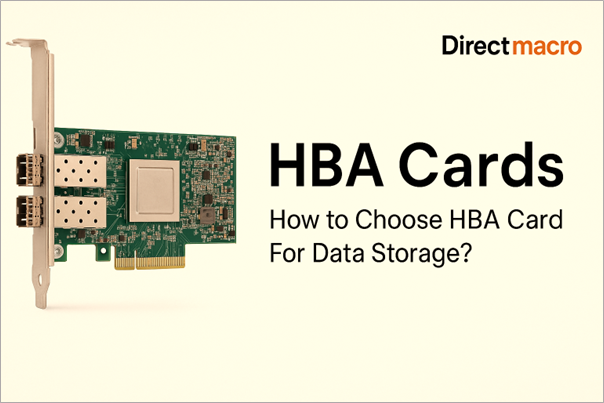Internal SSD vs External SSD – Which Type is Best for Gamers, Creators and Power Users?
Choosing the proper storage solution is crucial, whether you are a competitive gamer, a professional video editor, or a power user with a demanding workload. The debate between internal SSD vs external SSD options remains ongoing, as both types offer significantly faster performance, more storage space and longer lifespan compared to regular hard drives. But which one is best for you?
This comprehensive guide will examine the pros and cons of internal SSDs and external SSDs. We will also compare their performance in different situations and help you choose the one that best meets your needs and budget.
Why Solid-State Drives (SSDs) are Essential?
Before we get into the debate about internal SSD vs external SSD, let’s quickly go over why SSDs have become the best option for modern computers. SSDs use flash memory instead of spinning platters and read/write heads like hard disk drives (HDDs). This fundamental difference means:
- Blazing Speed: SSDs make booting up, loading applications and transferring files much faster.
- Enhanced Durability: SSDs are less likely to break when dropped, shocked or vibrated because they don’t have any moving parts. They are great for both internal and portable use.
- Improved Efficiency: They use less power, which means laptops have longer battery life and desktops run more quietly.
- Silent Operation: SSDs don’t have any moving parts, so they operate silently.
If you want a faster, more reliable computing experience, these benefits make SSDs a must-have. But what kind of SSD do you need? Let’s find out the key differences.
Internal vs External SSD: Key Differences
The primary distinction between internal SSD vs external SSD lies in their connectivity and intended use.
Internal SSDs are installed directly inside your computer and connect to the motherboard via interfaces such as SATA or PCIe. They become an essential part of the hardware in your system.
You can connect external SSDs to your computer or other devices through a USB cable (such as USB-A or USB-C) or Thunderbolt. They are portable and can be used independently. They are designed for mobility and easy to transfer files between devices.
The first step in our SSD buying guide for gamers, creators and power users is to understand these fundamental differences. This is the chart that shows the differences between internal SSD and external SSD:
| Feature | Internal SSD | External SSD |
| Installation | Installed inside PC/laptop | Plug-and-play via USB/Thunderbolt |
| Performance | Faster with NVMe (PCIe) | Slower, limited by USB interface |
| Portability | Stationary | Portable and travel-friendly |
| Power | Uses internal system power | Powered through USB |
| Upgrade Options | Ideal for permanent upgrades | Great for expanding storage externally |
The choice between an internal SSD vs external SSD ultimately depends on how you plan to use your storage.
Performance: How Fast is External SSD vs Internal SSD?
It’s essential to understand the various interfaces when discussing performance.
1.Internal SSD Performance
Internal SSDs usually have faster speeds, mainly when used with modern interfaces.
- SATA SSDs: These usually have read/write speeds of about 500–600 MB/s, which is a massive improvement over HDDs and is more than fast enough for everyday use.
- NVMe (Non-Volatile Memory Express) Internal SSDs: These are the speed kings. NVMe internal SSDs can achieve remarkable speeds when connected via the PCIe (Peripheral Component Interconnect Express) interface. The newest PCIe Gen 5 drives can reach speeds of up to 12,000 MB/s. This direct connection to the motherboard reduces latency and increases data throughput, making them ideal for applications that require high power.
2.External SSD Performance
The performance of external SSDs depends a lot on the USB or Thunderbolt interface they use and the port on your device.
- USB 3.1 Gen 2 (USB 10Gbps): Can reach speeds of up to 1,000 MB/s. Many popular external SSDs, such as the Samsung T7 series, utilize this technology.
- USB 3.2 Gen 2×2 (USB 20Gbps): Capable of speeds up to 2,000 MB/s. Drives like the Transcend ESD420 portable SSD utilize this technology to achieve great speed on the go.
- Thunderbolt 3/4: These interfaces offer the fastest external connections, with speeds of up to 40Gbps (about 5,000 MB/s). They can even compete with some internal NVMe drives. However, your device requires a Thunderbolt port for them to function.
So, how fast is external SSD vs internal SSD in terms of speed? An NVMe internal SSD will almost always be faster than even the fastest USB external SSD, because it connects directly to the system with a high-bandwidth connection. However, a high-speed external SSD with USB 3.2 Gen 2×2 or Thunderbolt can still significantly faster than a SATA internal SSD.
Internal SSD vs External SSD for Gaming
Storage speed directly impacts game load times, texture streaming, and overall responsiveness. So, finding the right internal SSD vs external SSD for gaming performance is crucial. Here, we discuss the pros and cons of internal SSD and external SSD for gaming, helping gamers find the right SSD for their system.
1. Internal SSD for Gaming
- Pros: An internal SSD for gaming (especially NVMe) loads games the fastest, which means less waiting and smooth texture pop-in. Install your operating system and frequently played games on an internal NVMe drive is the best internal SSD for gaming performance.
- Cons: Limited by the number of slots available in your PC or console (especially on consoles like the PS5 that need specific, high-speed internal expansion drives). Internal SSDs are not portable So, you can’t take your game library to a friend’s house.
2. External SSD for Gaming
- Pros: External SSDs are portable. They offer portability to carry your game library between PC or console. An external SSD for PS5 and Xbox gaming is excellent for storing and playing older games (like PS4 games on PS5 and Xbox One/360 games on Xbox Series X/S) as well as storing current-gen games. However, to play PS5/Xbox Series X/S games, you typically need to transfer them to the internal drive.
- Cons: An external SSD is faster than an internal SSD for gaming, but it usually takes a little longer to load current-gen games because of interface overhead. Not all external SSDs are fast enough to meet the requirements for playing next-gen console games directly.
Verdict for Gamers: An internal NVMe SSD for your OS and main games is paramount for primary gaming rigs. An external SSD is a great way to add more games to your library, especially for older titles or for transporting games.
Internal SSD vs External SSD for Creators and Power Users
Content creators (like video editors, graphic designers, and music producers) and power users are constantly working with large files, complex programs, and doing multitasking. So, finding the right internal or external SSD for creators and power users are crucial. Here, we discuss the pros and cons of internal vs external SSD for creators and power users to help them finding the right SSD.
1. Internal SSD for Creators/Power Users
- Pros: An NVMe internal SSD is a must-have for professional video editing, 3D rendering, and big project files. Its unmatched speed makes it possible to edit high-resolution videos (like 4K and 8K) in real-time, render them faster, and quicker application launches. The low latency and high throughput of an internal NVMe drive are significant for tasks where every second counts.
- Cons: Internal SSDs for creators and power users are only use when you install it inside your PC or laptop. An internal drive isn’t helpful on its own if you need to collaborate with others or move projects between workstations.
2. External SSD for Creators/Power Users
- Pros: Portable SSD vs internal storage for power users highlights the external drive’s key advantage: mobility. The main benefit of an external drive is that it is portable, unlike an internal drive. An external SSD enables creators to transfer their large project files, samples, and assets to various workstations, client sites, or locations. The best external SSD for professional video editing will have Thunderbolt or USB 3.2 Gen 2×2 ports for fast transfers of large media files that makes it a powerful “project drive.”
- Cons: Even the fastest external SSDs can encounter interface bottlenecks that slightly reduce performance compared to a direct NVMe internal connection, particularly during sustained, high-read/write operations.
Verdict for Creators and Power Users: Often, the most effective strategy is to employ a combination of approaches. Use a high-capacity NVMe internal SSD for your main working drive for apps and current projects. Use a fast and sturdy external SSD for project archives, transferring files, and collaborating on the go.
NVMe Internal SSD vs USB External SSD: What Should You Choose?
The use case of SSDs is matters a lot and makes all the difference when you compare NVMe internal SSD vs USB external SSD.
1. Choose NVMe Internal SSD if you need:
- The best performance for starting up, playing games, rendering, or editing
-
- Seamless performance without cable clutter
- Long-term upgrades to your system
2. Choose USB External SSD if you need:
-
- Portability and use on cross-device
- Fast backup and transfer of large files
- More storage without opening your system.
Portable SSD vs Internal Storage for Power Users
Power users often switch between multiple workstations or transfer large amounts of high-speed data. Here is how both options meet their needs:
- Portable SSDs allow you to easily carry terabytes of data, which is great for on-site editing, traveling, or syncing data between workstations.
- Internal SSDs give you constant high-speed access and are better for tasks like running VRMs, compiling code, and working with large datasets.
A hybrid approach is best: use internal NVMe for tasks that need speed, and portable SSDs for moving data and offloading.
SSD Buying Guide for Gamers, Creators, and Power Users
Choosing the right SSD involves considering several factors:
Capacity
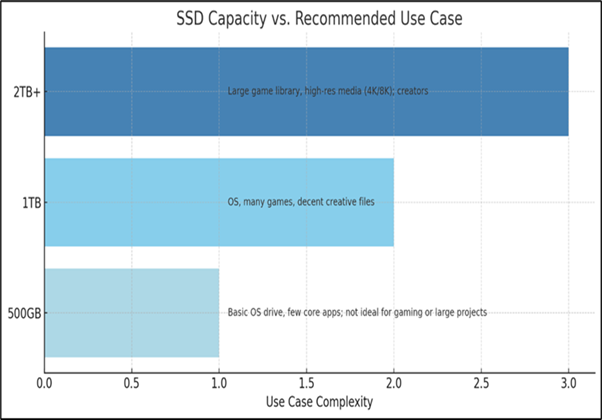
-
- 500GB: Good for a basic OS drive and a few core applications. Not ideal for extensive gaming or large creative projects.
- 1TB: A common sweet spot. Sufficient for an OS, many games, and a decent number of creative files.
- 2TB+: Recommended for serious gamers, anyone with an extensive game library, or creators dealing with high-resolution media. For 4K/8K editing, a storage capacity of 4TB or more is often preferred.
Form Factor (Internal SSDs)
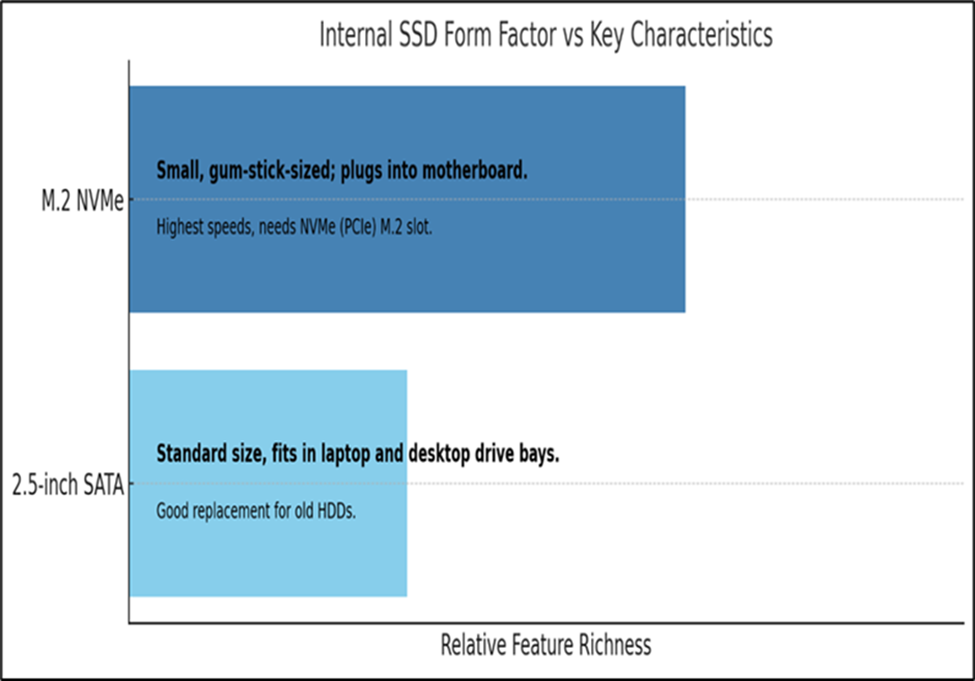
-
- 2.5-inch SATA: This 2.5-inch SATA has the standard size and fits in both laptop and desktop drive bays. A suitable replacement for old hard disk drives.
- M.2 NVMe: These are small drives that look like gum sticks and plug directly into the motherboard. They offer the fastest speeds. Ensure your motherboard has an M.2 slot that supports NVMe (PCIe)
Interface (Internal & External)
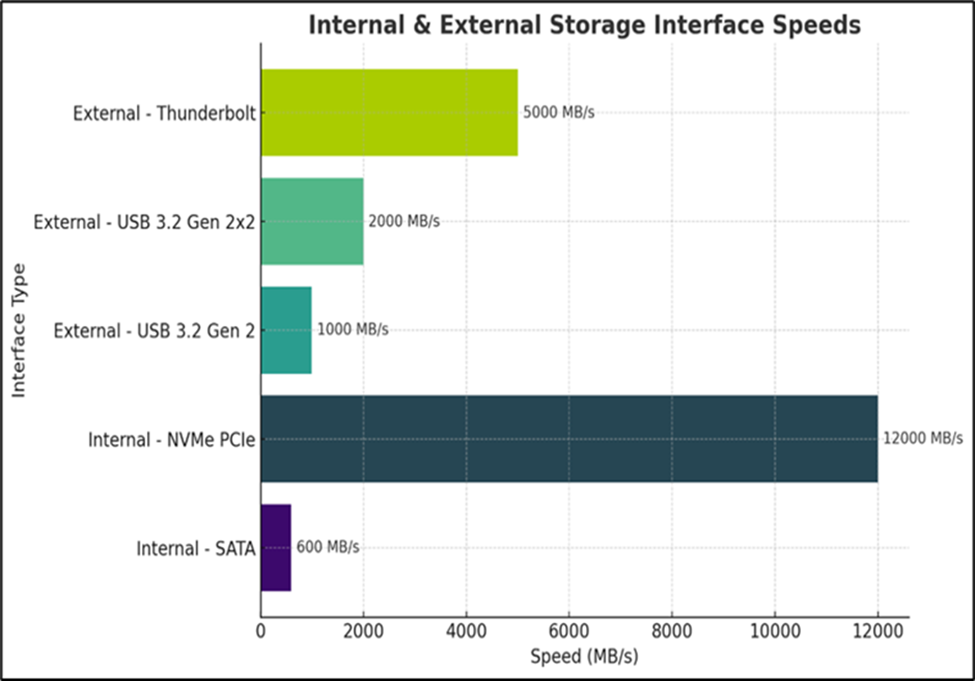
-
- Internal: SATA (up to 600 MB/s) or NVMe/PCIe (3,500 MB/s to over 12,000 MB/s). NVMe is crucial for achieving optimal performance.
- External: USB 3.2 Gen 2 (10Gbps/1,000 MB/s), USB 3.2 Gen 2×2 (20Gbps/2,000 MB/s), or Thunderbolt (40Gbps/5,000 MB/s). To achieve the best speed, ensure that the external drive’s interface matches the fastest port on your computer.
Durability and Features (External SSDs)
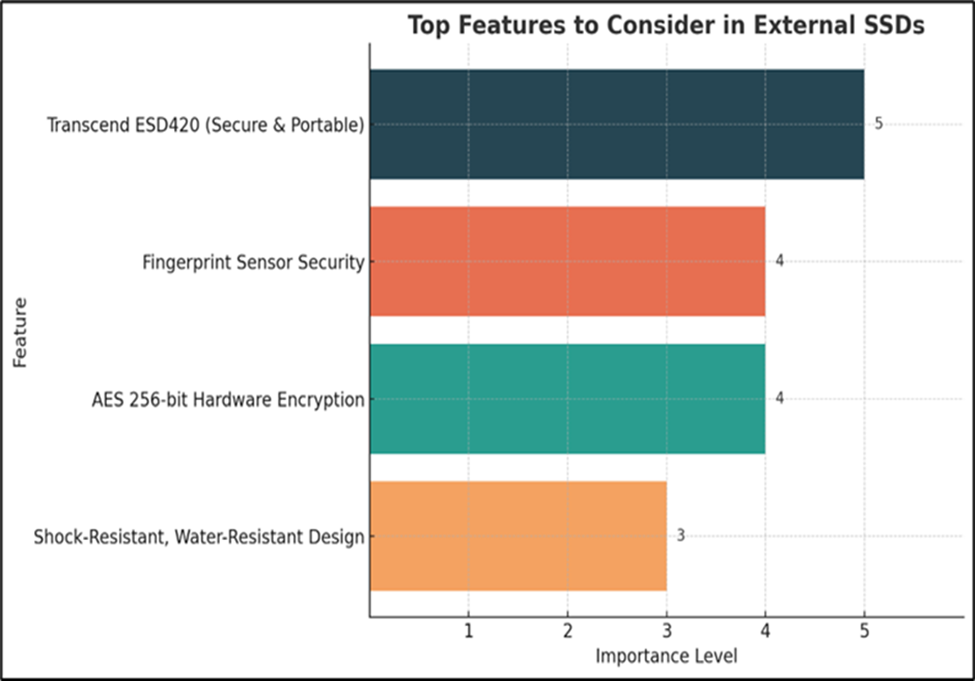
-
- If you travel a lot, look for designs that are shock-resistant, water-resistant, or ruggedized.
- Think about adding hardware encryption (like AES 256-bit) and fingerprint sensors to make things safer, especially for sensitive creative projects or personal data. The Transcend ESD420 portable SSD is an excellent example of a drive that is both secure and easy to carry around.
Budget
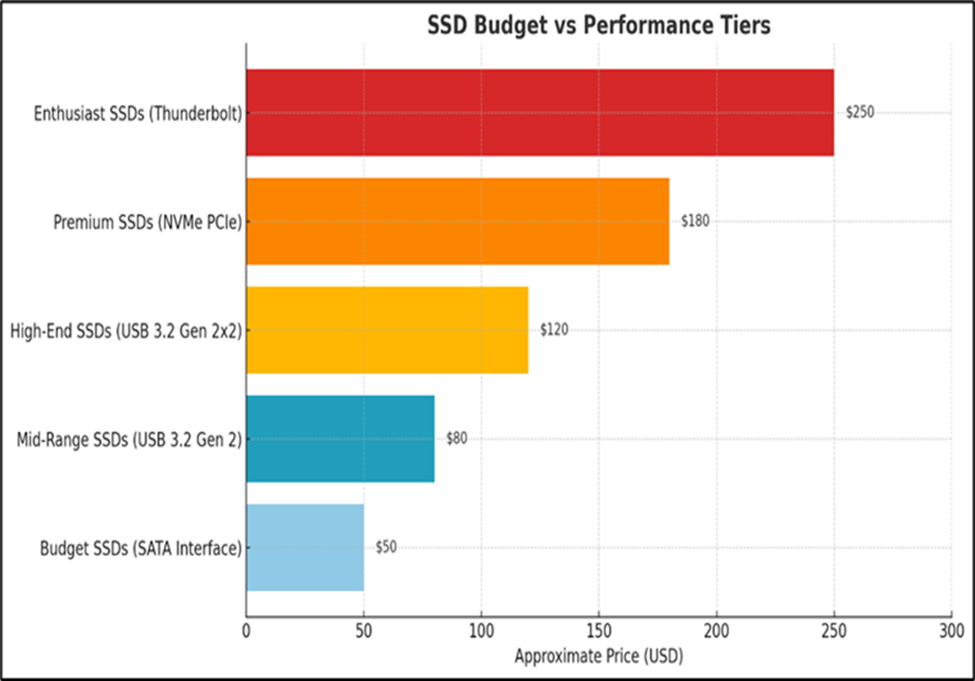
- SSDs are becoming increasingly affordable, but higher capacities and faster interfaces, such as NVMe and Thunderbolt, remain more expensive. Balance your performance needs according to your budget.
Recommendations: Best Use-Cases for Each Type
| Use Case | Best SSD Type |
| Competitive PC Gaming | NVMe Internal SSD |
| Console Storage Expansion | USB External SSD |
| 4K Video Editing on Laptop | Thunderbolt External SSD |
| Running Virtual Machines | Internal SSD (NVMe preferred) |
| Sharing Large Files Between Devices | Portable USB SSD |
| Budget Build Upgrade | SATA Internal SSD |
Final Verdict: Internal vs External SSD – Who Wins?
In the battle of internal vs external SSD, there is not only one answer fit. In short:
- Gamers who want fast loading times and smooth gameplay should get an NVMe internal SSD.
- Professional video editors and creators who are always on the go should get the best external SSD for professional video editing, especially if it has Thunderbolt connectivity.
- Power users get the best of both worlds by using both portable SSDs for flexibility and internal SSDs for peak performance.
Conclusion: A Synergistic Approach
It’s not always a matter of choosing between internal vs external SSDs in the debate. For gamers, creators, and power users, the best solution often involves the strengths of both.
- Get a fast NVMe internal SSD to use as your primary drive for your operating system, demanding apps, and current projects/games that need the best performance.
- Add a fast, reliable external SSD for expending your games library, transfer large creative projects, make secure backups, and use it on multiple devices. This strategy gives you the best of both worlds: fast internal speeds and unmatched external portability.
You can create a storage solution that elevates your gaming, creativity, and productivity to new heights by carefully considering your workflow, hardware, and budget.
Frequently Asked Questions
Q1: Is solid state drives are better then Hard Disk Drive?
Yes, solid-state drives (SSDs) are significantly better than Hard Disk Drives (HDDs) for faster speed, more durable, more efficient, and quieter than hard disk drives (HDDs). Because they don’t have any moving parts, they boot up, load applications, and transfer files much faster.
Q2: Which SSD is the best option for power users?
A high-capacity NVMe internal SSD is the best SSD option for power users. Due to its high speeds and low latency, it excels in tasks that require intensive processing, such as 4K and 8K video editing, as well as handling large amounts of data.
Q3: Which internal and external SSDs are in demand for gamers?
Both internal and external SSDs are very important for gamers.
Internal SSDs in Demand for Gamers:
- Samsung 990 Pro NVMe SSD: Top-tier Samsung 990 Pro NVMe internal SSD for extreme speed and game load times.
- WD_BLACK SN850X NVMe SSD: The most in demand WD_BLACK SN850X NVMe SSD are available with great performance and thermal management for gaming that takes a lot of power.
- Crucial P5 Plus NVMe SSD: If you are looking for the strong speeds and great value for a solid gaming upgrade then don’t miss out Crucial P5 Plus NVMe SSD.
External SSDs in Demand for Gamers:
- Samsung T7 Shield Portable SSD: This is durable, have fast USB 3.2 Gen 2 (10Gbps). Samsung T7 Shield Portable SSD best for external SSD for PS5 and Xbox gaming with backward-compatible and storage.
- Crucial X10 Pro Portable SSD: This Crucial X10 Pro Portable SSD has very fast USB 3.2 Gen 2×2 (20Gbps) speed in a compact design.
Do you need advice on buying or selling hardware? Fill out the form and we will return.

Sales & Support
(855) 483-7810
We respond within 48 hours on all weekdays
Opening hours
Monday to thursday: 08.30-16.30
Friday: 08.30-15.30



